Are Urban Planning Policies Inflating Australian Property Prices?
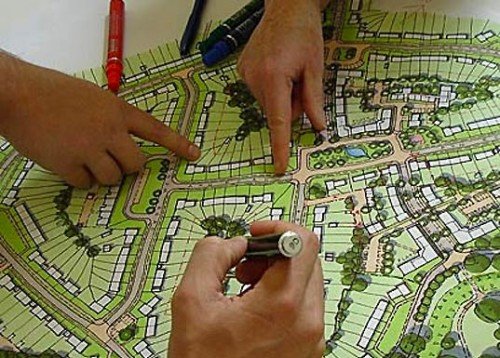
Every year, a private consultancy firm in the United States called Demographia publishes its “International Housing Affordability Survey.” The report ranks the most affordable and the least affordable major metropolitan markets in the developed world. It focuses on major cities in Australia, Canada, Hong Kong, Ireland, Japan, New Zealand, Singapore, the United Kingdom and the United States.
In the most recent survey, Australia was in the spotlight, as both Sydney and Melbourne were near the top of the list of the most unaffordable cities in the world. Hong Kong is the most expensive, but Sydney came in at the number two spot. Vancouver narrowly beat out Melbourne at number three.
Affordability = Median House Price / Median Income
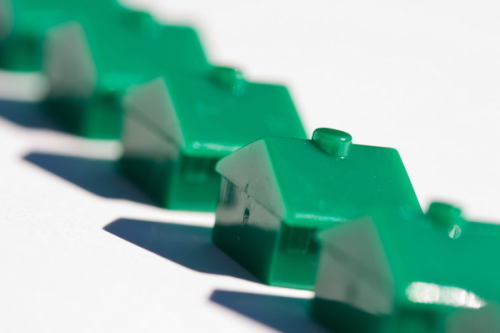
To effectively measure affordability, it’s necessary to compare median house prices in a market to median incomes. This can be expressed as a ratio, for example “four to one,” where home prices are four times annual income. The same figure can also be expressed as a “median multiple,” such as simply “four” instead of “four to one.”
Demographia considers a median multiple of 3.0 or less to be “affordable,” while a median multiple over five is “severely unaffordable.”
Here’s a list of the top ten least affordable major metropolitan markets of the world:
- Hong Kong: 19.0
- Sydney, NSW: 12.2
- Vancouver, BC: 10.8
- Melbourne, VIC: 9.7
- Auckland: 9.7
- San Jose, CA: 9.7
- San Francisco, CA: 9.4
- London: 8.5
- Los Angeles, CA: 8.1
- San Diego, CA: 8.1
The ten most affordable major cities were all in the United States:
- Buffalo, NY: 2.6
- Cincinnati, OH: 2.6
- Cleveland, OH: 2.6
- Rochester, NY: 2.6
- Pittsburgh, PA: 2.7
- Detroit, MI: 2.8
- Grand Rapids, MI : 2.8
- Oklahoma City, OH: 2.8
- Saint Louis, MO: 2.8
- Columbus, OH: 2.9
As you can see, Melbourne is nearly four times more expensive and Sydney is nearly five times more expensive than the most affordable city, Buffalo, NY. If it’s any consolation, though, Hong Kong is nearly twice as expensive as Melbourne.
As I’ve written about before, Sydney got a lot more expensive over the past year. Over that time, the median multiple jumped 2.4 points, up from 9.8 last year. This was the largest one-year increase ever recorded by Demographia.
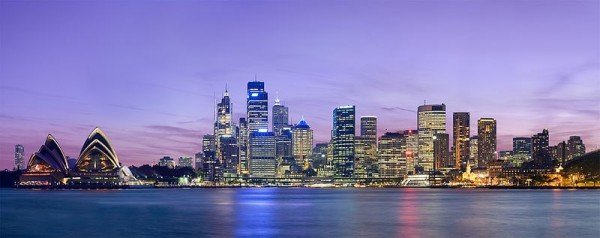
The survey also noted two other interesting facts about the Sydney housing market:
Swiss-based financial services company, UBS Group, rated the city as the third most vulnerable market in the world to a real estate correction, behind London and Hong Kong.
Sydney’s housing affordability is worse than on the U.S. West Coast during the housing bubble of 2007.
Looking at Australia as a whole, it ranks as the least affordable place in the world to live, outside China. Demographia claims the nationwide median multiple is 5.6, but as Macro Business recently pointed out, the median of all of our cities weighted against population looks a lot more like 8.4 to one.
No matter how you measure it, Australia is clearly an expensive place to buy real estate.
Is Urban Containment the Reason Real Estate Is So Expensive?
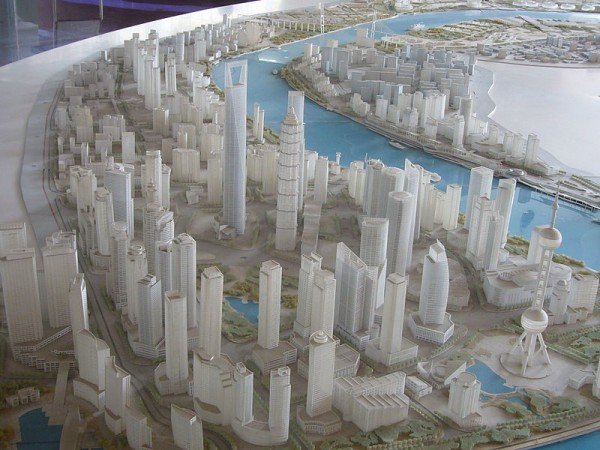
Most economists point to factors that impact demand, such as favourable tax concessions, the availability of cheap credit, foreign investment, state first homebuyer grants, proximity to jobs, and booming population growth through immigration. But the Demographia report highlights a different factor, one on the supply side.
The survey unapologetically blames inflated property prices on local councils and “strong land use regulations” aimed at urban containment. Urban containment is the practice of councils placing barriers around suburban expansion to encourage density near public transport and within walking distance of suburban shopping.
Demographia claims that these policies “severely ration land for development” by restricting supply and forcing density growth into specific areas through zoning laws.
In the introduction to the report, a Senator for South Australia and also a property developer, Bob Day sounds off on the issue. Here’s what he says:
“It is undeniable that demand factors played a role in stimulating the housing market… However, the real culprit, the real source of the problem, was the refusal of local and state governments and their land management agencies to provide an adequate and affordable supply of land for new housing stock to meet demand.”
The historical data seems to back up his view. Prior to 1987, median home prices in Australia remained for the most part within the range of 2.0 to 3.0 times median household incomes, as the following graph indicates:
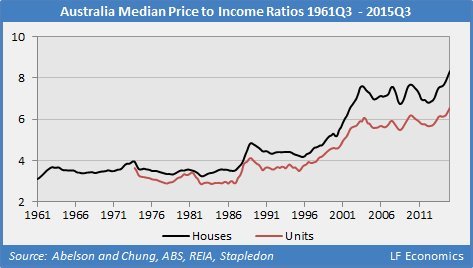
It just so happens that it was also in 1986 and 1987 that urban containment policies began emerging within state planning departments. Since then, councils have continued to heavily regulate density and restrict development to predetermined zones.
And since that time, unaffordability has been on an upward trajectory.
Demographia’s report further highlights that urban containment and high property prices tend to go together throughout the world. It notes that every metropolitan market with “severely unaffordable housing” in their survey has “severe restrictions or even prohibitions on new housing development on and beyond the urban fringe.”
It’s tough to make a case to deny the connection between urban containment policies and high property prices. But is this simply the price Australians must pay for a high quality of life?
Melbourne consistently ranks as the most livable city in the world.
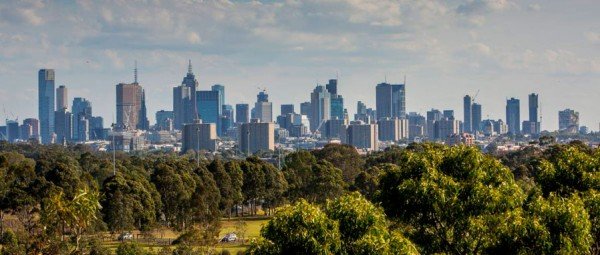
Is it a coincidence that four of the five most unaffordable cities in the world all make the top-ten list of The Economist’s most “liveable” cities? Perhaps not considering the high priority that the liveability survey places on infrastructure and environment.
What Could This Mean for the Future of Australian Property Prices?

I’ve long held to the conviction that the ultimate reason real estate is so expensive is the availability of cheap credit. In fact, I could point to changes in banking regulation in the 1980s as the primary cause of housing price growth from that point.
But Demographia makes some strong assertions, which means zoning laws in Australian capital cities may very well provide a floor under real estate values, if and when the next economic shock wave comes from overseas. Of course, if banks can’t loan money, all bets are off.
Nonetheless, if belief that urban containment is the primary culprit of high property prices gains momentum in public opinion, political pressure may grow, forcing state planners to loosen development restrictions. This could place downward pressure on property values, regardless of credit markets.
For the time being however, the property bulls in Australia can hang their hats on the artificial supply constraints being created by city governments.
What about your local housing market? Are government urban planners contributing to unaffordability where you live?

Governments creating artificial monopolies. Sounds familiar.
What do you think about the problems of urban sprawl on the environment? Should we concerned about that? Is government trying to do something to "help"?
Good question. I haven't thought much about it really. Australian local governments do a pretty good job thinking about lifestyle of residents but there's an obvious economic benefit they reap in the form of property taxes on inflated real estate.
I'm curious to know your thoughts as an Anarchist about how you would avoid indiscriminate property development that detracts from quality of life without some "authority" planning what can be built and where. Unfortunately property developers often prioritise profit above beauty and quality of life for residents.
I've only recently been thinking more philosophically about property and the influence of architecture on well being. I don't think we can "force" things without using social shaming, ostracism, reputation, and the like. It may not turn out as "nice" if we can't force people to do things our way via the threat of violence, but at the same time we could also have some interesting emergent properties where new, creative ideas could be explored and rewarded.
I'm still thinking through this stuff and how humanity can get along without having to use force or threats of force. I think it's possible, but it might need to be done on much smaller scales. Decentralized, self-sustaining communities might be the key.
Perhaps we'll see more and more people experimenting with such communities in the future. Any move toward decentralisation would be a good one!
I'm in Sydney, and it's depressing trying to find a place to live. Housing shouldn't be a luxury, a play thing for the super rich, housing should be available for everyone that can afford it... I mean, I work a full time job in IT, my wife works as a professional part time in the health care industry and we're unable to find a suitable place to buy. We don't have unrealistic expectations, I mean Sydney is the land of the $1,000,000.00 asbestos shack, which come complete with rotting floorboards, leaking taps, outside toilets.... and we can't even afford one!
WTF Australia, I love you but you're bringing me down
Funny! I hadn't heard that one.
It's true though. What people are paying to knock down and rebuild boggles the mind.
Hold out. I think things will move back in your favour at some point soon.
Ironically - I recently started looking at rental property in Cleveland area. Affordability is one of the main reasons.
What's the cap rate looking like on properties there? Would you believe Sydney is somewhere around 1.5 or maybe 2 percent?
Oh my goodness. Put it this way - I'm struggling to find 7% in South Florida so am looking elsewhere. I was happy with 8% on my last property and many U.S. investors were telling me they don't look at anything under 10%
You have to go to the midwest mainly to find plus 10% now. Of course you really don't ever see any appreciation there, steady as she goes though! Tempted to sell my FL properties and book profit. Prices have recovered so aggressively past 5 years
1.5 to 2% sounds alot like San Francisco and NY. I wouldn't touch those properties.